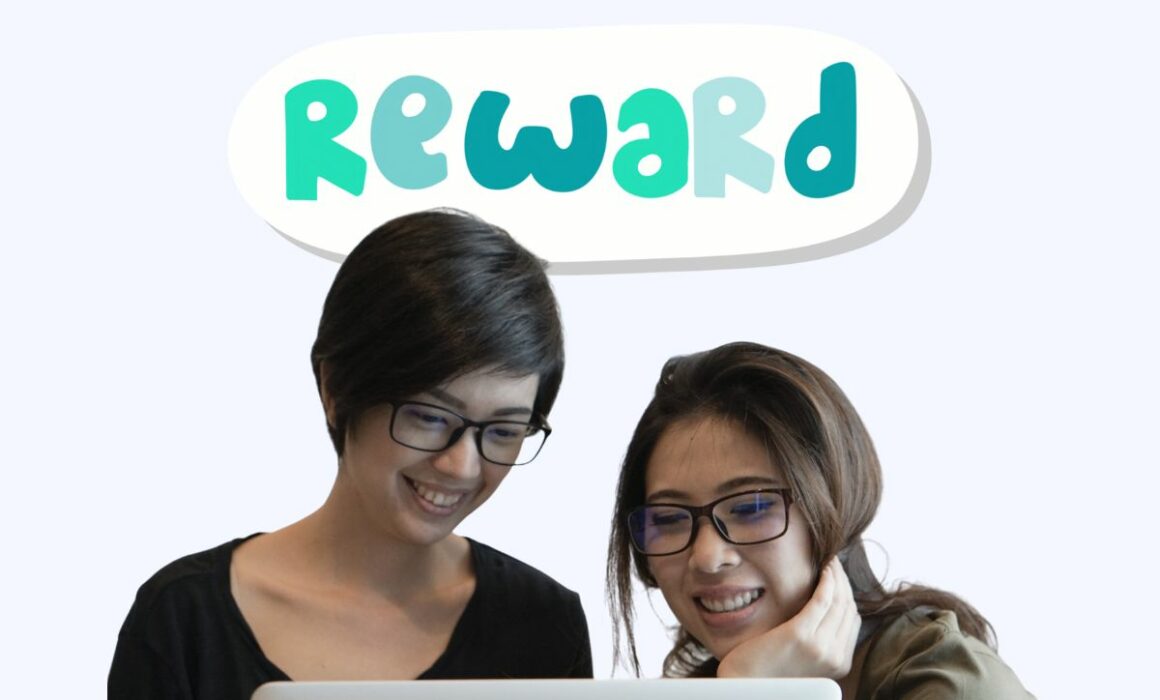Enhancing Product Engagement Through Gamification Strategies
Product engagement is the lifeblood of successful businesses, driving customer success, loyalty, and revenue growth.
Organisations are turning to well-designed gamification strategies to cultivate a deep and lasting connection with their target audience. By integrating game-like elements into the product experience, businesses can create a captivating environment that motivates users to engage actively.
This article delves into gamification and explores the most effective strategies that can elevate product engagement to new heights.
Table of Contents
- Understanding product engagement
- Understanding gamification
- The role of gamification in driving product engagement
- Where product engagement and gamification intersect
- Effective gamification strategies to drive product engagement
- Implementing gamification in your business
- Conclusion
- Machine Learning In Finance: 12 Essential Applications
- How To Create Interactive Compliance Training For Bank Employees
- How Fintech Apps Are Using Gamification To Increase User Engagement
- Top Gamification Companies for Employee & Customer Engagement
Download your free
“Gamification Guide”
Get your PDF now and start transforming your approach to digital engagement!
Understanding product engagement
Product engagement is the level of interaction, involvement, and overall product usage by its users or customers. It goes beyond mere usage. Instead, product engagement focuses on creating a deep and meaningful connection between users and the product.
When users engage with a product, they are actively involved, invested, and motivated to derive value and satisfaction from their interactions.
Components of product engagement
Product engagement measures how actively and frequently one engages with the product or service. It is a broad yet highly specialised field that includes all the important individual interactions with the product and overall user experience.
Your business’s product engagement score encompasses three key components:
- Cognitive engagement involves the user’s mental and intellectual involvement with the product. It includes understanding the product’s features and benefits, researching its functionalities, and gaining knowledge about its capabilities.
- Emotional engagement — As the term suggests, emotional engagement captures the user’s feelings and experiences with the product. It can range from delight and excitement to frustration or disappointment, depending on the user’s overall experience with the product. Building positive emotional connections is crucial as they keep customers happy while creating a sense of attachment to the product.
- Behavioural engagement — The user’s actions and behaviours towards the development are the focus of this component. Behavioural engagement is an essential indicator of user satisfaction and loyalty, reflecting how users actively integrate the product into their lives. It includes how frequently users interact with the product, how long they use it, and their willingness to recommend it.
The importance of product engagement
Product engagement plays a vital role in the success and longevity of a product or service. For one, measuring product engagement can help create essential visibility that lets you better understand what you can do better.
Here’s why product teams must prioritise and measure product engagement metrics and identify opportunities to enhance overall product engagement:
#1. Customer loyalty
Engaged customers are likely to become loyal advocates for your product. When users feel strongly connected to a product, they are more inclined to remain faithful, repurchase, and recommend it to others. By nurturing product engagement, you can cultivate a community of loyal customers who contribute to the growth and sustainability of your business.
#2. Increased sales and revenue
This is one of the most important things that make product engagement essential. Customers actively involved with your product are more likely to dedicate their time, finances, and energy.
In addition to product usage, they will likely opt for advanced features, make supplementary transactions, and explore your brand’s alternative products. This heightened customer expenditure directly corresponds to increased sales and revenue for your company.
#3. Valuable feedback and insights
Active users frequently contribute valuable feedback, suggestions, and insights to enhance your product. Their input illuminates areas for improvement, potential new features, and market trends. You can continuously improve your product and outpace competitors by attentively listening to engaged users.
Factors influencing product engagement
Several factors influence product engagement among daily, monthly, and weekly active users. Understanding these factors can help you develop strategies to enhance active users’ engagement levels.
Here are a few key elements to consider:
- Value proposition — A compelling value proposition that fulfils a genuine need or solves a problem for users is crucial in driving engagement. When users see the value of your product in their lives, they are more likely to engage and become loyal customers.
- Design and user experience — Your product’s design and user experience significantly impact engagement levels. A well-designed, intuitive, and visually appealing interface enhances user satisfaction, encouraging them to explore the product’s utility more deeply.
- Personalisation and customisation — This allows users to tailor the product to their preferences. It creates a sense of individualisation that fosters a deeper connection and increases user engagement.
- Enjoyment and entertainment value — People naturally enjoy enjoyable, challenging, and rewarding activities. By incorporating gamification elements, such as badges, leaderboards, and rewards, you tap into the innate desire for achievement. Plus, it creates a captivating and entertaining experience that keeps users engaged and motivated.
Download your free
“108 Gamification Elements and Mechanics”
Get your cheat sheet and have a quick reference at your fingertips!
Understanding gamification
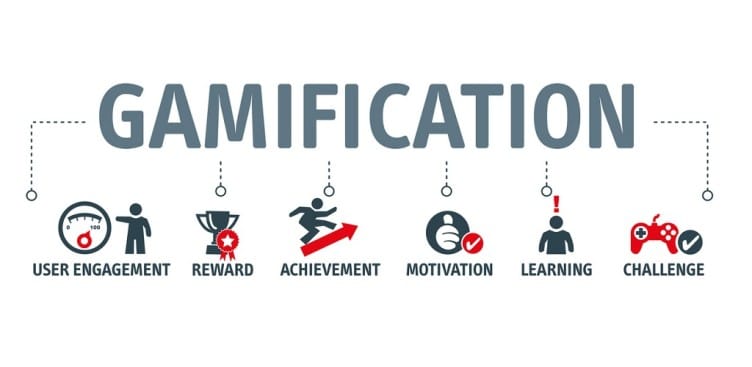
Gamification is the application of game mechanics in non-game contexts to engage and motivate users. It incorporates challenges, rewards, leaderboards, and progress tracking to make experiences more enjoyable, interactive, and engaging.
At its core, gamification harnesses the power of intrinsic and extrinsic motivators to drive user behaviour.
Intrinsic motivators, such as curiosity, mastery, and a sense of accomplishment, come from within the individual. These are closely tied to personal satisfaction and enjoyment. On the other hand, extrinsic motivators involve external rewards, recognition, or incentives provided by the system or organisation.
By carefully balancing these motivators, gamification creates an environment that motivates users to perform desired actions and achieve specific goals.
Key elements of gamification
- Goals and objectives — Gamification sets clear goals and objectives for users to achieve. These goals provide a sense of purpose and direction, driving users’ engagement and motivation.
- Progression and advancement — Gamification incorporates a sense of progression and advancement through levels or stages. Users can track their progress, unlock new challenges, and experience a sense of accomplishment as they move forward.
- Rewards and recognition — Providing rewards and recognition through points, badges, or virtual goods reinforces desired behaviours, encouraging users to continue engaging with the product. It triggers a sense of achievement and satisfaction.
- Competition and social interaction — Gamification often includes elements of competition, such as leaderboards or challenges against other users. This fosters social interaction, encourages friendly rivalry, and adds an extra layer of engagement.
Overall, gamification takes advantage of our natural inclination to play and compete, transforming routine or mundane experiences into dynamic and exciting ones. Businesses can capture and maintain user attention by infusing gamification elements into various domains. But more importantly, make the overall experience more enjoyable and rewarding.
Here’s the complete list of gamification examples.
The role of gamification in driving product engagement
Gamification taps into fundamental human motivations and behaviours, making the user experience more enjoyable, compelling, and immersive. In this way, gamification is a powerful driver in getting the most from a brand’s engagement activities.
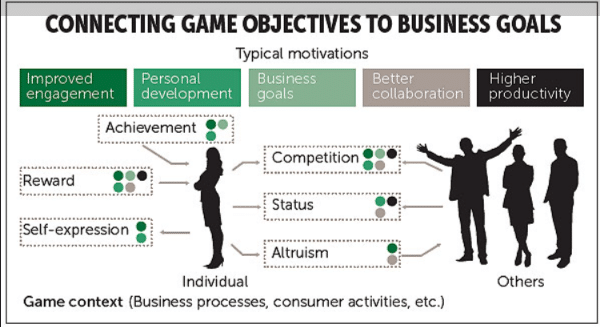
Source: bangkokpost.com
Here are some ways in which gamification enhances active user engagement with a product or service:
#1. Increased motivation
Gamification triggers users’ intrinsic motivation by providing clear goals, challenges, and rewards. This motivation propels users to actively participate and invest their time and effort into the product.
#2. Sense of achievement and progress
By incorporating progression and advancement mechanics, gamification allows users to track their progress over time. More importantly, they experience a sense of achievement as they reach milestones or unlock new levels. This sense of progress keeps users engaged and motivated to continue their journey.
#3. Enhanced user experience
Gamification transforms mundane tasks into enjoyable and interactive experiences. It adds fun, excitement, and challenge, making the user experience more captivating and memorable. Even better, it appeals to both individual users and groups.
#4. Social interaction and community building
Incorporating social elements like leaderboards, collaborative challenges, and shared achievements encourages social interaction and user collaboration. This builds a community and promotes ongoing overall engagement.
Benefits of incorporating gamification in products
Incorporating gamification into products and experiences offers numerous benefits for businesses, which include:
- Increased engagement and retention — By captivating users’ attention and providing enjoyable and rewarding experiences, gamification boosts engagement, encourages commitment, and promotes repeated interactions.
- Improved learning and skill development — As a powerful tool for learning and skill development, gamification offers interactive challenges, feedback, and a sense of progression. This enables users to acquire knowledge and skills more engagingly.
- Data collection and insights — Businesses can gather valuable data on user behaviours, preferences, and performance through gamification. This data informs product enhancements, targeted marketing, and personalised user experiences.
- Brand differentiation and competitive advantage — Integrating gamification can help lead to a more engaging product that stands out from competitors, providing a distinct and captivating experience. This compelling differentiator attracts and retains customers, granting you a competitive advantage in the market.
Where product engagement and gamification intersect

Source: easypromosapp.com
Gamification emerges as a powerful strategy to captivate users and create immersive experiences, which can promote active user engagement. Combining these two concepts creates a synergy that drives unparalleled product engagement metrics.
The science behind gamification and product engagement
Gamification is not just about adding game elements to a product; it is rooted in psychological principles that tap into human motivation and behaviour.
Psychological principles in gamification
Understanding human behaviour and cognitive processes to create engaging and immersive experiences that drive desired actions and outcomes is crucial in gamification.
By leveraging psychological principles, organisations can effectively utilise gamification to improve engagement, learning, and overall user experience.
Motivational factors and incentives in gamified experiences
By harnessing motivational factors, gamification can massively enhance product engagement. It fosters intrinsic motivation through challenges, feedback, and personalisation, including achievement, mastery, and autonomy.
Additionally, extrinsic motivators like rewards, recognition, and competition significantly drive people to take action, ultimately increasing product engagement.
Gamification design considerations for effective product engagement
Designing a successful gamification strategy requires careful consideration of various factors:
- Understand your audience — Thorough user research is essential to understand your target audience’s preferences, motivations, and gaming behaviours. This knowledge will guide you in designing gamified elements that resonate with their interests and increase engagement.
- Define clear objectives — Define the goals you want to achieve through gamification. Whether increasing user retention or fostering product adoption, having a clear direction will help align your gamification efforts with desired product engagement outcomes. This also allows the product team better measure engagement levels over a given period.
- Choose relevant game mechanics — Choose those that align with your objectives and resonate with your audience. Challenges, rewards, leaderboards, and progress tracking are familiar mechanics that can drive engagement. Choose those that are most relevant to your product and user base.
- Incorporate progression, feedback, and personalisation — Design gamified experiences that offer a sense of progression, regular feedback, and personalisation. Users should feel a sense of growth, recognise their achievements, and have opportunities to customise their experience.
Effective gamification strategies to drive product engagement
Below are some key gamification strategies that can enhance user engagement and create a more engaging experience for multiple users:
Rewards and incentives
Offering rewards for specific actions is a powerful gamification strategy that motivates users to engage with a product.
Starbucks, the renowned Seattle-based coffee chain, exemplifies this through their highly successful program called Starbucks Rewards. The program’s popularity continues to soar, with nearly 21 million loyal members as of 2021.
Starbucks Rewards goes beyond convenience, offering enticing benefits to its members. Notably, customers can conveniently top up their accounts and skip queues by ordering ahead.
Another brand embracing rewards is Reebok, a prominent athletic footwear and apparel company. Besides traditional gift-based plans, Reebok provides members exclusive VIP experiences, comprehensive training and wellness programs, and exciting partner rewards.
Implementing a rewards system
Introduce badges, points, or virtual currencies users can earn by completing certain tasks or reaching specific milestones. These rewards acknowledge their accomplishments and provide a tangible representation of their progress.
Offering tangible or intangible rewards
Besides virtual rewards, consider offering tangible incentives such as exclusive content, discounts, or access to certain features. These rewards create a sense of exclusivity and further motivate users to engage with the product actively.
Progression and unlockable content
This gives users a clear pathway to advance and a feeling of accomplishment as they engage with the product.
Allowing users to unlock new levels or key features
Design the product experience so users can unlock new levels and drive new feature adoption as they progress. This creates a sense of achievement and curiosity, encouraging users to continue engaging to open up more.
Providing a clear pathway for advancement
Ensure that users understand the steps to advance and achieve goals. By offering a well-defined progression system, users feel a sense of direction and purpose, which promotes continued engagement.
Social interaction and competition
Humans are inherently social beings, and incorporating social interaction into the gamified experience creates a sense of community and drives engagement.
Nintendo exemplifies this with games like Animal Crossing. Players can visit and interact with each other’s virtual islands, trade items, and communicate through in-game messaging. Additionally, Nintendo offers online multiplayer features, allowing players to compete or cooperate with friends and strangers alike.
Another notable example is Roblox. This user-generated gaming platform promotes social interaction through real-time chat, collaborative game development, and shared gameplay experiences.
Leaderboards and challenges
Implement leaderboards that allow users to compare their achievements and compete. This fosters a sense of competition, motivating users to strive for better performance. Additionally, introduce multiplayer options that enable users to collaborate or challenge their friends, promoting social interaction and engagement.
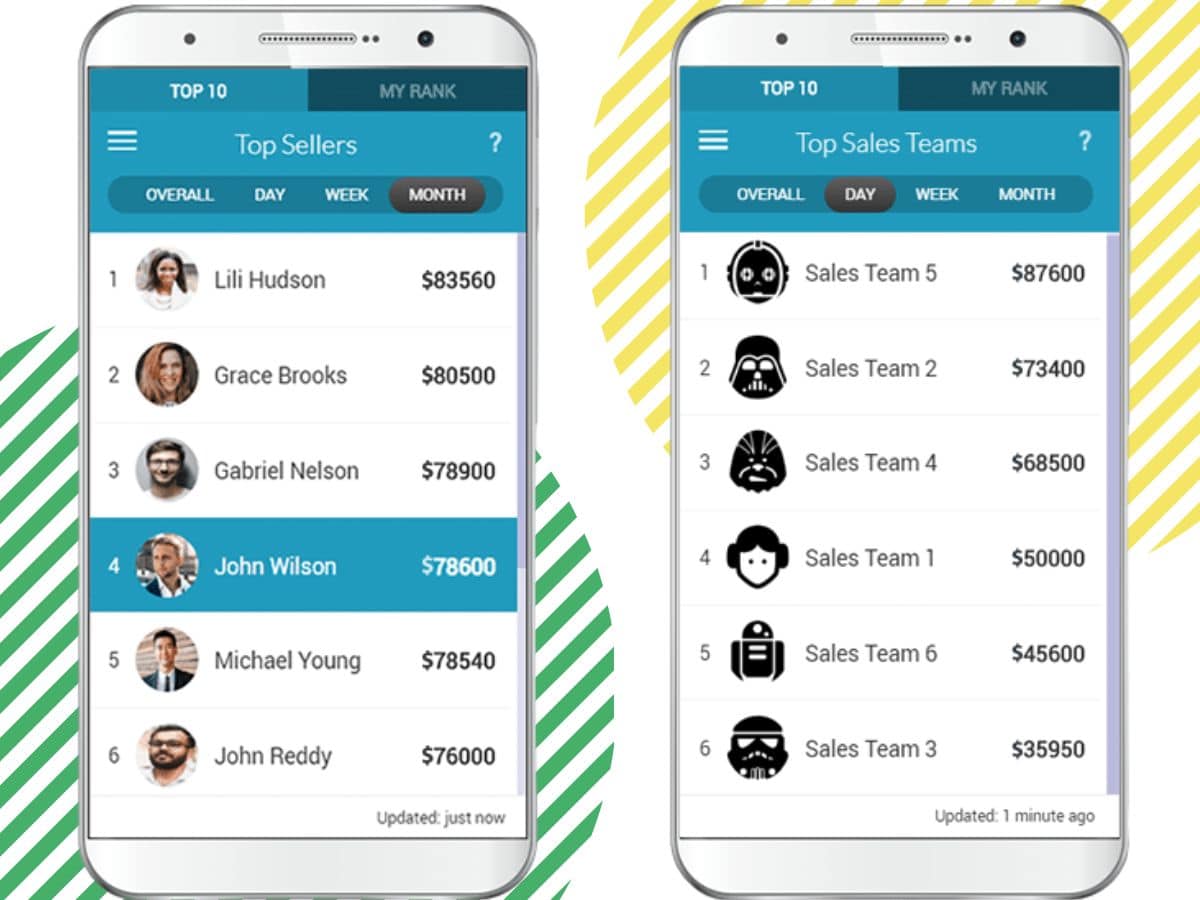
Creating a sense of community
Design the gamified experience to encourage users to interact with one another, share their progress, or collaborate on common goals. This sense of community enhances engagement as users feel connected and supported by like-minded individuals.
Personalisation and customization
Allowing users to personalise their experience adds a personal touch and fosters a sense of ownership. When users can tailor the gamified features to their preferences, it enhances their engagement and connection to the product.
Avatar customisation and profile personalization
Provide options for users to create and customise their avatars or profiles within the gamified experience. This allows users to express their individuality and makes a more profound sense of personal connection to the product.
Tailoring gamified features to preferences
Allow users to adjust the settings or parameters of the gamified elements based on their preferences. For example, users could choose the difficulty level of challenges or select specific types of rewards. This customisation empowers users and increases engagement by aligning the experience with their unique preferences.
Real-time feedback and progress tracking
Users want to see their progress and receive immediate action feedback within the gamified experience. Coupled with product analytics, feedback and progress tracking can be a powerful way to enhance product engagement. These insights provide essential visibility into what problem users need help with and how your gamification efforts perform.
Below are some ways to track this:
- Immediate feedback on user actions — Ensure users receive prompt feedback on their actions or performance within the gamified experience. This feedback can be in the form of visual cues, sound effects, or notifications. It allows users to see the direct impact of their actions and promotes continued engagement.
- Progress tracking and visual representation — Incorporate progress bars, milestones, or other visual representations of users’ advancement within the gamified experience. This optical tracking mechanism provides a sense of accomplishment and motivates users to strive for further progress.
Storytelling and narrative elements
Introducing storytelling and narrative elements into the gamified experience creates a captivating and immersive journey.
People are naturally drawn to stories; leveraging this element in gamification enhances emotional connections to the core product and sustains engagement.
Compelling storylines and quests
Design the gamified experience around captivating storylines, characters, and quests that unfold as users progress. Immersing users in a narrative-driven experience creates emotional connections and a desire to uncover what happens next. This ultimately drives continued product engagement.
Emotional engagement through storytelling
Use storytelling techniques to evoke emotions and make the gamified experience more meaningful to users. Whether creating a sense of excitement, curiosity, or empathy, an emotionally engaging experience captures users’ attention and encourages them to stay engaged.
Challenges and goals
Introducing challenging tasks, missions, or quests is a core element of gamification. You can drive continued engagement with new users by setting clear goals and giving them a sense of purpose and achievement.
Challenging tasks and missions
Incorporate tasks or missions that require users to demonstrate specific skills or complete objectives. These challenges create a sense of accomplishment when users overcome them, boosting engagement and satisfaction.
Clear goals and milestones
Set clear goals for users to strive for within the gamified experience. Well-defined goals give users a sense of purpose and direction, motivating them to stay engaged. Examples of such goals include reaching a certain level, collecting a specific number of points, and completing a series of tasks.
Implementing gamification in your business
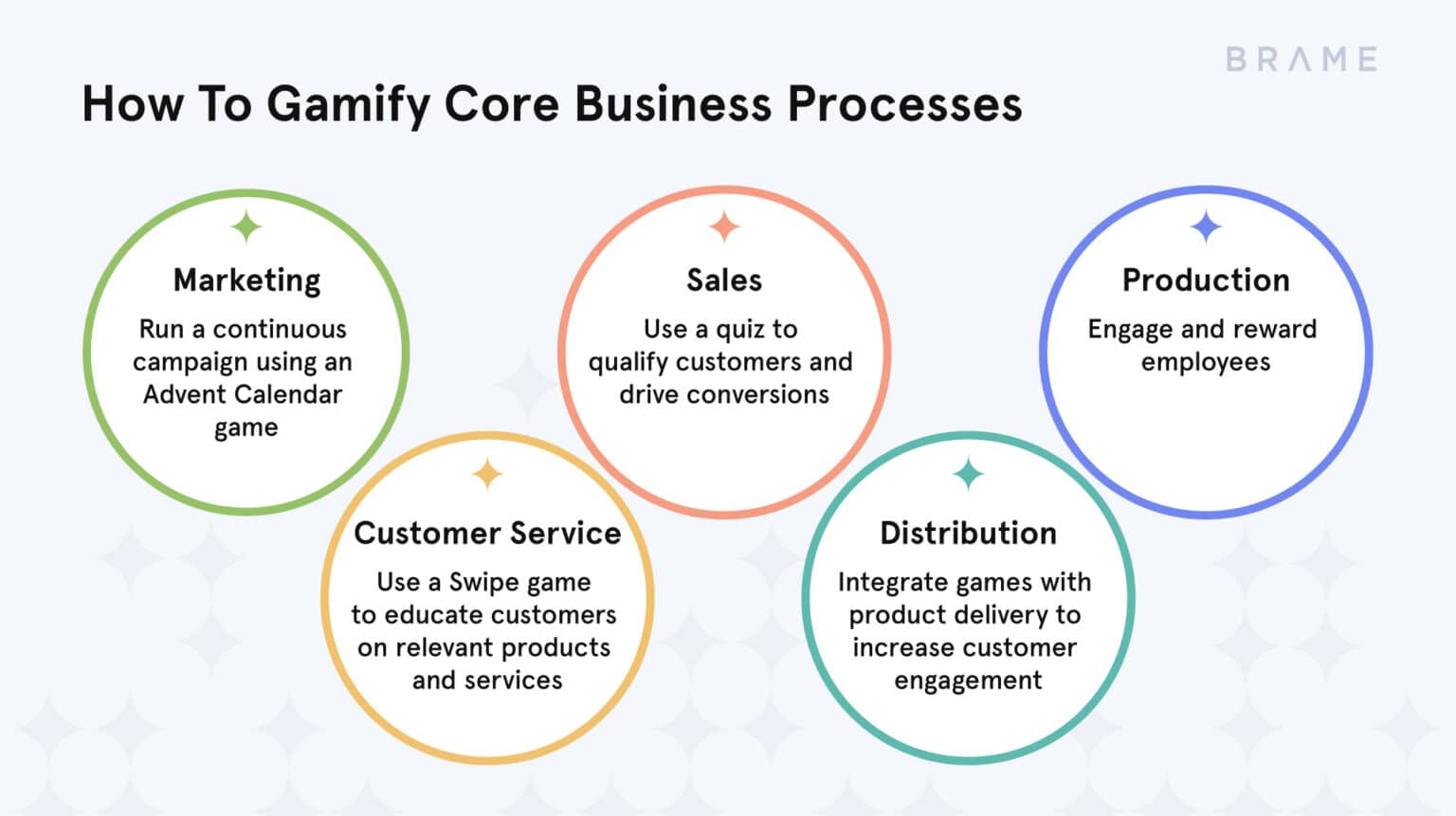
Source: brame.io
There are many ways to integrate gamification into your business’s product engagement model. It can be as simple as optimising the user onboarding process. In any case, there are several considerations to consider before getting started.
Assessing suitability for gamification
Before diving into gamification implementation, it’s crucial to assess the suitability of gamification for your specific product and target audience.
- Determining applicability — Evaluate if and how gamification can enhance product engagement in your context. Not all products may be suitable for gamification, so consider the nature of your product and its target audience.
- Conducting user research and analysis — Gain deep insights into your target audience’s preferences, motivations, and behaviours through user research and analysis. This will help you understand their engagement patterns and identify gamification elements that resonate with them.
Gamification implementation techniques
- Platform compatibility — Consider the platforms where your product will be accessed. This includes web, mobile, and any other relevant media. Ensure that the gamification elements are compatible and seamlessly integrated across all platforms.
- Scalability — Plan for scalability to accommodate the growth of your user base. Ensure the gamification elements can scale effectively to handle increased user interactions and engagement.
- Ongoing maintenance — Gamification is a continuing process. That’s why measuring user engagement from time to time is paramount. Regularly monitor and maintain the gamification elements to keep them fresh, engaging, and relevant. Consider introducing new challenges, updating rewards, and responding to user feedback.
Conclusion
Combining gamification and product engagement is a game-changing strategy businesses can leverage to capture and maintain customers’ attention. By understanding the components of product engagement and recognising its importance, companies can develop effective strategies to enhance engagement levels.
As we look to the future, gamification will continue to play a crucial role in driving meaningful user experiences and fostering brand differentiation. It can also help unlock the full potential of product engagement and improve the overall health of your business.
Latest Posts
Machine Learning In Finance: 12 Essential Applications
The impact of machine learning on finance is significant. Thanks to this technology, financial institutions are now equipped to make efficient decisions. Through the analysis of data sets, machine learning […]
How To Create Interactive Compliance Training For Bank Employees
Banking compliance training isn’t just another task. It’s the stage where everything else performs. Banks must navigate a myriad of regulations and laws. After all, this is a trust-driven, high-stakes […]
How Fintech Apps Are Using Gamification To Increase User Engagement
Discover how gamification in fintech is revolutionizing financial engagement, making banking fun & boosting user loyalty.
